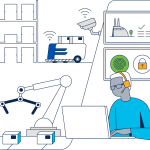The lines of where and how office workers conduct their daily duties are blurred. Technology and regulatory mandates have enabled, but also forced flexibility of working from home or going to the office. Is this the case now for manufacturing workers and their first line support teams? Maybe.
As organizations managed through the pandemic, they were challenged to keep operations going, while prioritizing worker safety. This seemed relatively easy for office workers who could simply work from home with a digital interface and a secure internet connection. Some used laptops or desk-top computers, and others were supplied with stand-alone end points that had all the collaboration functionality needed for productive meeting experiences.
However, in the world of manufacturing, the challenges of finding new ways to work were similar to those of office workers heading home, only with additional levels of complexity. Globally, 31% of the top ten largest industries by employment are in the manufacturing space, totaling just over 35 million workers from three of the ten biggest industries.
Granted, not all of those employed in the manufacturing industries are plant workers, but it’s safe to say they make up a significant portion. In a “lock-down” environment where social-distancing was mandatory, just how did frontline manufacturing workers go about conducting their jobs to provide us with the goods that we all consume? They social distanced, wore additional PPE, and adopted new practices and technologies to interact with their dispersed co-workers.
With the “great resignation” and the on-going retirement of the baby boomer generation, training and keeping newly hired employees is challenging. In interviews with some manufacturing executives, we’ve heard that it can up to 60 days to train a new hire, and even then, retention is not guaranteed. Thus, more efficient and cost effective tools are needed. Augmented Reality Technologies, Remote Experts and Digital Twins are all being used as a means of training and on-boarding newly hired employees. Combating this problem head on was Hirschmann Automotive who utilized Webex Expert on Demand to increase first time fix rates, improve the speed of first time resolution, while reducing travel expenses.
Unless we are talking about “dark plants,” or highly automated plants, manufacturing workers will always be on-site and won’t be able to work from remote locations. It only makes sense to provide this majority of the workforce in manufacturing with the same digital mobility and collaboration tools that office workers have otherwise we risk losing an even greater mindshare of the next generation thinking about careers.
Learn how Cisco is making hybrid work possible for manufacturers today:
Hybrid Work for Manufacturing (Website)
Empowering Manufacturers with Hybrid Work (Webinar On Demand)

Good, Thank You… what about the Hybrid A.I that won’t need human assistance
Sorry – I don’t quite understand the question?
Ok